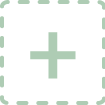If you’re a seamstress or a quilter, you know how hard it is to throw away tiny scraps. I’m going to show you how to reuse those little pieces to create gorgeous new textiles.
Tips:
1
For this project, we’ll be using Sulky Ultra Solvy. It’s a clear film that dissolves completely in water. There are a few different brands of water soluble stabilizer, as well as several types of Solvy. But I’m using Ultra Solvy because of its thickness as well as its adhesive properties, which I’ll talk about more later.
2
Start saving the little strips of fabric that are left over when you straighten the edge of your fabric cuts. I also like to save the extra fabric when I trim my seam allowances.
How to:
made with
I’m going to show you a few different techniques, so you can choose the one that works best for your project.
Pocket Method
1
First we’ll try the pocket method. Cut a piece of Ultra Solvy that’s the same size as your backing fabric. Lay it on top of the fabric and pin. Sew around 3 sides with a ¼ inch seam, creating a pocket. (You’re sewing through very thin layers, so you may need to adjust your tension and lengthen your stitches a bit.)
2
Fill the pocket with scraps. Do your best to push the fabric down into the corners and edges. (The Ultra Solvy stabilizer is fairly thick, so you don’t need to worry about it ripping.)
3
Sew the top of the pocket shut with a ¼ inch seam.
4
Now we’ll topstitch a design across the entire top of the pocket. If you have a free motion quilting foot, that will make this step go faster. If you’d like to learn more about that, I have a tutorial with instructions on free motion quilting. However, you can also do this with a standard foot, which is what I’m using right now.
5
I’m doing wavy lines, but you can do straight lines or a grid pattern or anything else you’d like. the trick is to keep your rows close together so the fabric scraps will be held securely.
The pocket method is nice for making quilt squares because it leaves a border for a seam allowance. The downside is that depending on the size of your squares, it can leave a lot of excess Solvy scraps. So let’s talk about a second method.
Adhesive Method
1
Ultra Solvy is unique because it becomes sticky when wet, and can be used like an adhesive to hold our fabrics together. Place your fabric scraps on top of your backing fabric. This method gives you a little more control over placement, which is nice.
2
Take a piece of Solvy, or several Solvy scraps, and dip them in water. Place on top of the fabric and gently press down with your finger to adhere.
3
We have to let the Solvy dry completely until it’s no longer tacky. If you’re in a hurry, you can use a blow dryer to speed up the process.
4
Top stitch the layers together as shown previously.
Quilted Method
1
You can also quilt the new textile as you go. I used the adhesive method to create my top fabric, then placed it face down. Add a piece of batting in the middle, and a backing fabric face up on the top of the stack.
2
Quilt together with a design. Trim the edges if necessary.
3
You can then bind the edges with bias tape or ribbon to create a mug rug, placemat, or wall hanging.
No Backing Method
1
You can also make a new textile with no backing at all. Layer two pieces of Solvy together and sew on three sides as we did with the pocket method.
2
Stuff the pocket with scraps. (You can also get creative with these, adding strands of fibers or ribbons to make some really interesting textures.)
Removing the Solvy
1
To remove the Solvy film, soak in warm water for 15 minutes.
2
Rub gently to remove the residue. You can then place in the dryer.
Made By Marzipan may have received product or payment for this post. Posts may contain affiliate links. Disclosed in accordance with the Federal Trade Commission's 16 CFR, Part 255.






 Finished?
Finished?